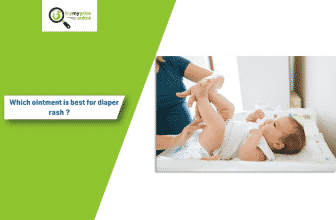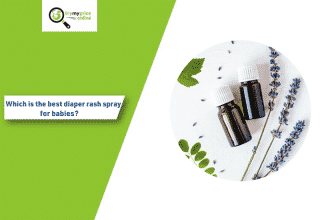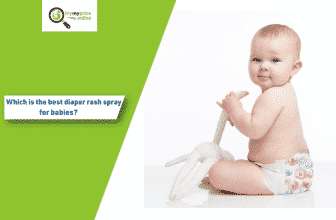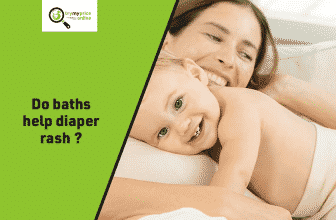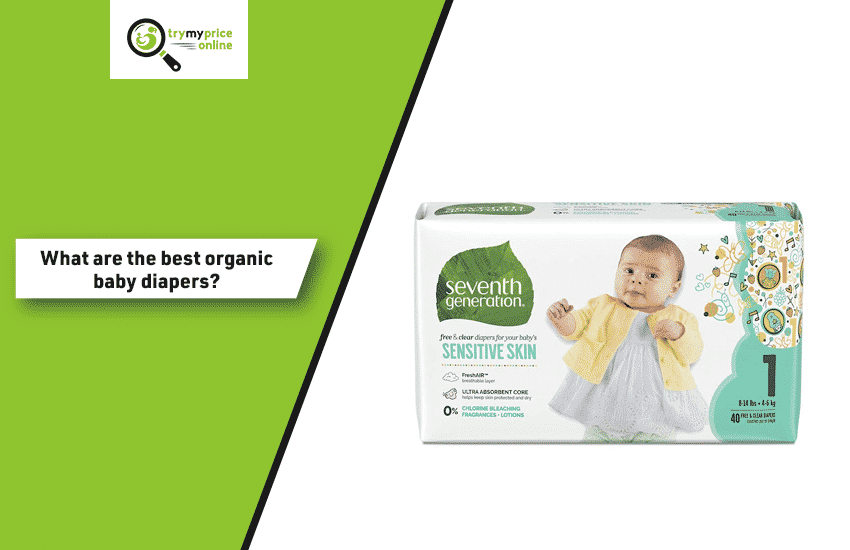
You may experience anxiety when your baby knocks into your life, more if you are your first parent. The choice of the best cloth for use and the best organic baby diapers can be enormous.
Premature baby diapers can cause an allergic reaction and are sensitive to a newborn baby.
Therefore, because of diaper rash, it can be agonizing to find the bottom look red. The right type of paint for your baby will avoid such a scenario. Since the market has many different brands, deciding the best style that will not cause an allergic reaction can be challenging.
The quality of the paintings and organic baby diapers are also of particular concern to parents and caregivers. We have compiled the best organic baby diapers for use in our review. Please continue to read as we dig into the subject.
Are organic baby diapers Worth It?
When a kid is born, mom and dad are quickly launched into a world full of baby pads for diapers, rashes, restless nights, apparently never-ending fits of sorrow, and stress. So, parents want nothing but the best for their babies and are bombarded with products touting the benefits of green and organic products.
But organic baby diapers often come at an attached cost, and families on tight funds may have to prioritize what organic matters are worth the price tag. Mallon makes an anomaly when it comes to food and pays higher rates for certain organic food stocks.
“We understand about the difficulties with the use of medicines and hormones in our food and farm and the results that can have on children, and we know about the harm DEET, and other pesticides can cause, etc.… So, I’m usually ready to pay for organic produce, whatever the extra cost is to get organic. “
Why do Pampers smell like chemicals?
While the cloth is much better for the environment, the necessary dumping and cloth washing is a twist for some, and cloth cleaning can be costly. Moreover, while there are widely available organic clothes, some mums feel worth no money after too many leaks or blowouts.
“Your baby’s in pains throughout the day… they’re sweating in the premature baby diapers. I, therefore, believe that you must prioritize another critical decision.
“Jones said it’s what to put on the bottom of a baby. Companies like the seventh generation offer chlorine, fragrance, latex, and dry diapers. Also, big brands such as Huggies have a similar line.
Every new parent knows how quickly the cost of pains increases and even priced organic paints are. So to maintain costs, experts suggest that they choose chlorine-free couplers at least. All right, so you’re on the overwhelming baby aisle now.
Where do you begin? Where do you start? While many different views exist on avoiding non-toxic paint strips in your search, these are the ingredients we believe are essential to dodge.
- No Fragrance:
We have much more fragrance information here. Still, we know that the term fragrance is a parachute term that allows manufacturers to hide a cocktail of over 100 chemicals without disclosure.
The aromas industry regulates itself, and manufacturers must not list their aromas on product labels because fragrances are regarded as “business secrets.” Fragrances are associated with an incredible number of health risks.
Fragrance products are classified as allergens Chemicals disturbing hormones, asthma triggers, neurotoxins, and carcinogens through multiple research studies. Even worse, fragrant products often contain phthalates that help fragrances last and are not listed on the labels of ingredients. In European Union products, the brandless baby diapers have been banned for use.
However, although research has shown that hormonal interference is caused by these chemicals and developmental and reproductive toxicity, the United States still permits their use. They are harmful and cancerous to a little boys or girls in a baby diaper.
- Bleach:
Bleach is asthma, allergies, environmental toxicity, and cancer-associated respiratory and skin irritants. In addition, it is used to manufacture baby basics diapers and leaves behind dangerous byproducts, called dioxins, one of the most science-focused and highly carcinogenic chemicals in EPA.
Dioxin exposure can lead to skin reactions, liver function, and immune, nervous, endocrine, and reproductive systems impairment. You don’t want your baby’s sensitive skin to be exposed 24 hours a day for your first couple of years.
To make them more secure, look for non-toxic, environmentally friendly brands with fully chlorine-free (TCF) diapers to avoid byproducts like dioxins from bleaching therapy
- Tributyl-tin (TBT):
The TBT is the antifouling agent and biocide used in the marine industry to prevent algae and barnacles from growing on the lower side of boats, avoiding the spraying of micro-organisms. However, it does have a significant downside, although it may sound great because it is highly toxic to aquatic life and linked to endocrine disruption.
Therefore, in your search for organic baby diapers, you should avoid this. Another point to take into account: Polyacrylate of sodium. Ever wondered how much liquid can hold a disposable diaper? This feature resulted in the past two decades from SAP, a super absorbing compound that absorbs fluids and causes surface tension in the painting lining to avoid leakage.
Suppose you’ve ever changed your baby’s basic diaper and seen gel-like beads stuck to their skin. It is SAP and is connected with skin irritation and respiratory diseases and was eliminated from tampons because of concerns that the shock syndrome was toxic (TSS).
However, because it hasn’t been used in diapers for that long, the long-term effects of SAP are unknown and, even among natural baby diaper brands, it is difficult to find products that don’t contain some form of Sap.
Nowadays, among the convenience and temporary items, reusable baby swim diapers seem to be a necessity. While commonly used, synthetic, single-use paint strips often contain chemicals like dioxins associated with long-term health conditions (World Health Organization, 2010).
The 1999 ‘Environmental Health Archives’ survey shows that disposable clothes should be seen as a factor that may result in asthma and respiratory problems for children or worsen them. Furthermore, babies’ soft, sensitive skin is prone to rash and allergic reactions because of harmful chemicals and substances in disposable or renewable pampers.
Do diapers have chemicals in them?
Diapers that are not natural are made up of many different kinds of chemicals. This is because the brandless baby diapers, from its fragrance to its absorbance, relies on chemicals. Some substances that are used in the manufacturing of baby diapers are discussed below:
Dioxins:
Most discardable clothes are white with chlorine bleached (Chemistryexplained.com), which occurs in the atmosphere, and the clothes in a byproduct called dioxins. The US Environmental Protection Agency lists dioxins among the most toxic chemicals known to scientists as highly carcinogenic (EPA). This chemical is harmful to be used in the premature baby diapers.
Sodium Polyacrylate:
The super-absorbent chemical compound sodium polycarbonate is used in many disposable couplers in the fillers. It consists of cellulose from trees mixed with polyacrylate crystals. This chemistry absorbs liquids and causes surface tension to bind fluids in the lining to prevent leaks.
Sodium polyacrylate is often seen on babies’ skin as tiny gel-like crystals and is believed to be associated with skin irritation or breathing problems. Due to toxic shock syndrome concerns, you removed this chemical from tampons.
Since it has only been used in paints during the last two decades, no research exists on sodium polyacrylate’s long-term health effects on infants. Hence the diaper companies should produce natural baby diapers instead of diapers having these chemicals.
Volatile Organic Compounds (VOCs):
Available slides often contain chemicals called volatile organic compounds (VOCs). This covers chemicals like ethylbenzene, toluene, xylene, and addiction. EPA-based, volatile organic compounds may irritate the eye, nose, throat, headaches, liver damage, and renal and central nervous systems. Certain VOCs can even cause human cancer. Hence it is very dangerous to be used in the premature baby diapers.
Other Chemicals:
Dyes, fragrances, plastics, and petrolatum’s are other chemicals commonly used in disposable diapers. For example, in sticky tabs, adhesive chemicals close the dry baby diapers and coloring, making labels and patterns that mark the diapers used with pigments. In some disposable wall panels, perfumes and fragrances are also used to help mask smells and odors.
There is no doubt that disposable painting is excellent but is it safe for babies? There are also several possible risks. Most of the parents do not know the adverse effects and the long-term effects that this product causes on the surroundings of a child’s reproductive organs 24 hours a day.
Slide proponents such as leak-resistant polymers, super absorbing polymers, and certain perfume-based chemicals have been implied with disposable paintings critical to all aspects from chronic diaper rash, breathing difficulties like asthma, male infertility, and even testicular cancer.
This article presents the health and other related problems of the use of devastating baby cords like cancer, damage to the liver, skin conditions, male infertility, congenital disabilities, breathing difficulties, depletions, environmental pollution, chemical toxins, etc.
What are the drawbacks of baby diapers?
As a parent, care of your baby’s health and well-being is your responsibility. Slides are certainly made life easier for the parents, but some disadvantages of drops should be reported to the parents. Here are the disadvantages of using the non-organic baby diapers for your child.
Babies’ skin is gentle and soft, and anything complicated can damage their skin. Unfortunately, certain manufacturers often use synthetic fibers, colorants, or other high-performance chemical products in making clothes. All of these harsh chemicals can cause sensitive skin damage and allergy to your baby. Choose a soft natural baby diaper instead.
Slide rashes in babies are common. Bacteria can raise more in the wet, non-organic baby diapers and lead to rashes if a damp diaper is left on a babe longer than usual. Ensure your child’s slide is regularly changed to the least amount of risk for skin infection and rashes.
Pampers are constructed with chemicals and synthetic products; it can be harmful to expose your baby for a more extended period. This is because you can use 8 to 10 natural baby diapers in a day, and more in the evening, on average. Moreover, if you expose your baby too complex chemicals, some of them may also lead to toxicity in your baby’s system. But if used intermittently, this is not of great concern.
The diapers are made of material to allow your baby’s urine to be absorbed. It can prevent the air from flowing effortlessly into the organic baby diaper and create a suitable condition for breeding bacteria and other germs. Excessive use of paint is also likely to catch your baby’s skin and other infections. Make sure your baby frequently changes its baby pads for diapers.
You can burn in your pocket a large hole if you rely solely upon diapers. On average, eight to ten slippers of your baby may need to be changed in one day and, in some cases, even more. Your research, however, consists of many natural baby diapers made from appropriate materials that are also affordable
Allowing your baby to wear dry baby diapers can cause a toilet problem with your baby most of the time. This is because babies are used to punching and tingling in a cloth, and parents also find this convenient; however, your baby may whispers and cramps it when you try to train your baby.
Training in toilets, which usually begins early in life, probably loses its importance in today’s world, given that the slides are too dependent. You can take your baby earlier for toilet training.
The use of diapers is on the rise, but it is not suitable for the environment. Many diapers get disposed of in the environment containing plastic, synthetic fibers, and other chemicals. All these are difficult to decompose and pose a threat to the environment. Some companies have come up with eco-friendly and natural baby diapers, too, so look for those.
The Healthy Diaper:
Test after test confirmed that every diaper is relatively safe for babies irrespective of eco-friendly, or synthetic conditions. But the healthiest available natural baby diapers are considered in many circles clothes made of 100% certified organic cotton. Eco-friendly sleeves with fewer chemical substances can also be found.
They’re not organic, however. It’s how a brand reacts to the skin of your baby. If you find rashes that can come from the tight dry baby diaper you use, you can see proof right there on the changing table. Or, you might find some diapers which your baby does not feel comfortable enough. You may notice red creases on your baby’s waist or legs where the elastic lies.
Huggies Snug & Dry Baby Diapers, Size 4, 180 Ct, One Month Supply, Kimberly-Clark Corp.
as of July 2, 2025 11:49 am
Price History
Statistics
| Current Price | $50.99 | July 2, 2025 |
| Highest Price | $50.99 | June 8, 2025 |
| Lowest Price | $50.99 | June 8, 2025 |
Last price changes
| $50.99 | June 8, 2025 |
In order of priority, the top five quality indicators for them are:
- Back sheet cloth-like: These organic baby diapers are made of cloth, and they are considered very healthy as they do not contain any chemicals.
- System for closing: The diapers closing system should be very reliable for the baby’s health.
- Absorbency: The ability of the diaper to absorb the liquid should be good.
- Leak guards: The diaper should have twin, rather than single, leg cuffs.
- Wetness indicator: The diaper should have the wetness indicator, so the parent should be well aware of the liquid situation of the diaper.
Diapers for babies with sensitive skin:
As soon as your baby comes, your life is all about three things: feeding, sleeping, and sliding. Your baby needs between 2500 and 3000 cords in its first year when it comes to lines. You pay the price on your wallet and the environment.
Although many cloth brands choose to do it, many are environmentally harmful and sit indefinitely in waste dumps. Add to this that most painting is not biodegradable, and it contains substances that can be harmful to your baby’s soft and sensitive skin.
Cloth slipping is the best choice for parents that want a natural baby diaper option. But if you don’t want the trouble with washing and folding, plant-based, eco-friendly, disposable and organic baby diapers clothes are the next best option.
OsoCozy - Prefolds Unbleached Cloth Diapers, Size 2(15-30 lbs), 6 Count - Soft, Absorbent and Durable 100% Indian Cotton Natural Baby Diapers - Highest Quality & Best-Selling Cloth Diapers Sold Online, OsoCozy
as of July 2, 2025 11:49 am
Price History
Parents select eco-friendly organic diapers for environmental efficacy, superior quality, and sensitivity to skin and allergies. But the cords are also very absorbing and fit — not to mention the wallet.
We have considered hundreds of reviews to choose the best eco-friendly slides you can buy. The term “organic baby diaper” is often used with “ecologically friendly” interchangeably. It should be noted. That can be tricky. While the cursors in this guide mostly use materials based on plants, they are not entirely organic nor unnatural.
Here are the best eco-friendly diapers you can buy:
Honest Diapers:
These natural and dry baby diapers are made like underwear without the side Velcro panels. This makes this painting an excellent transition to underwear for kids with potty training, a painting that they cannot take out quickly.
Parents like these diapers on sensitive skin to be very soft and gentle. But be warned: they are made in the UK, which may not be the cheapest option because shipping abroad and the size of other brands can vary.
Hello Bello Diapers:
The features include high absorption levels, stretching side panels, and many impressive features. Nothing in these dry baby diapers, made with plant-based central liners and sustainably grown fluff pulp, is shown by the lotion, fragrances, latex, chlorine processes, and phthalates. You can also choose from several delicious designs, including butterflies, dinosaurs, and seasonal dishes.
Andy Pandy Premium Bamboo Diapers:
Another green option is the highly absorbent bamboo of these Andy Pandy diapers, which are organic baby diapers and prevents blowouts without harmful chemicals (like latex, alcohol, phthalates, and chlorine).
The paintbrushes are naturally hypoallergenic and very biodegradable – ideal for green-value families! The moisture indicator and wicking properties are also viral for parents.
Luvs Ultra Leak guards Diapers:
Luvs is a budget-based go-to brand for parents, but the quality is not sacrificed. The couch has three protective slats to prevent fearful spills of pee and poop, extended sides that contain leaks, and a helpful indicator of wetness. In addition, “Night lock Technology” protects for 12 hours when your child snuffs.
Finally, Luvs will provide a full reimbursement within 45 days of purchase if you are unsatisfied with other big baby diapers.
Pampers Swaddlers Diapers:
Pampers Swaddlers list top of many “newborn best natural baby diapers,” and with good reason. They’re super absorbed, lightweight, hypoallergenic, and moisture-wicking.
You also have a moisture indicator to determine if your child needs to change. The size is another advantage. The majority of the brands that produce the painting are ‘newborn’ (with less than ten livres) to 6 (35 lbs or more) — but Pampers Swaddlers also have preemie sizes for those of less than 6 pounds.





